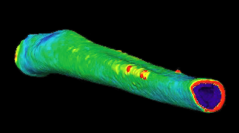

 Comptes Rendus Palevol
16 (4) - Pages 452-461
Comptes Rendus Palevol
16 (4) - Pages 452-461The opening of the Deux-Ouvertures cave is on the left bank of the Ardèche River, just before the canyon exit on the land of the village of Saint-Martin d’Ardèche in the Southwest of France. Although it has been known since 1896, the deep part of one of the galleries was not discovered until 1985. The surface of this gallery was covered by animal bones, 90% of which belonged to Ursus spelaeus. In 2007, two osseous human fragments were discovered: the distal part of an adult humerus and the diaphysis of a radius belonging to a young individual. These two specimens are the topic of the present paper. Although the date of the humerus (34,440–33,730 cal BP) corresponds to the period when bears frequented the caves, the dates of the diaphysis of the radius (4410–4570 cal BP), found at the heart of the “decorated Paleolithic sector”, lead us to assume that it was transported there, perhaps deliberately. The study of the two human bones originating in the Deux-Ouvertures cave illustrates that the diaphysis of the radius, belonging to a young individual of the Neolithic period, does not exhibit any differences in comparison to modern radii. By contrast, the distal part of the adult humerus, although it is incomplete and altered, is the first example that has been dated in the Ardèche of adult human remains associated with a decorated Paleolithic cave. This specimen, aside perhaps from the width of its median column, is rather slender and does not present any significant difference in relation to other upper Paleolithic humeri.
Distal extremity of humerus, Radius diaphysis, Gravettian human fossil, Neolithic human fossil, Decorated cave, Ardèche canyon